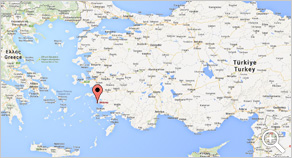DIDYMA

The ancient Didyma, called Didim today, situated in Aydın Province in the southwest of Turkey, was the most renowned sanctuary of the Hellenic world. It was connected to the great classical city of Miletus by a 17 kilometer-long Sacred Road. The area was settled in the Neolithic period, established as a colony of Crete followed by Mycenae in the 16th century BC, and subsequently possessed by Lycians, Persians, Seleucids, Attalids, Ancient Romans, and Byzantines as part of the province of Caria. The area came into the hands of Turks following the defeat of Byzantium at the Battle of Malazgirt in 1086. The town was captured again by the Byzantines in 1098, by Menteşe in 1280, and then Aydinids in 1300. Didim was brought into the Ottoman Empire by Sultan Mehmed Çelebi in 1413.
Apollo is considered to be one of the Twelve Olympians in Greek Mythology. He is the son of Zeus and Leto, and has a twin-sister Artemis, the Moon-Goddess. According to the legend, their mother Leto gave birth to the twins in Ortyga Woods. Didymaion means "twins" and this is the reason why the place where the Temple of Apollo stands was called “Didyma.”
The Temple of Apollo was built two times at the same place. The earliest structure of the temple was built in the end of the 8th century BC. All sides of the temple were surrounded by columns in the 6th century BC. This old temple was in the charge of the Branchids, who acted as priests and oracles. This word was derived from the name of Branchus, a favorite youth of Apollo. Three prose oracles and one dedication survive from this period. They ruled in this region for a very long and peaceful period. Pausanius, one of the writers of the first century, informs us that the cult seen in this region existed long before the Ionians arrived in Anatolia. The temple was completely destroyed by the Persians in 494 BC at the Battle of Lade and its treasures, including the ancient bronze statue of Apollo, were carried off to Ecbatana in Persia. In 334 BC a larger scaled temple was rebuilt for the second time on the same place by Alexander the Great after his arrival to Anatolia. Seleucus I Nicator, one of the Diadochoi of Alexander the Great, and the founder of the Seleucid Dynasty, commissioned the architects to design the building and brought the statue of Apollo back to its original place in Didyma.
The Temple, 109 meters long and 51 meters wide, used to be the third biggest temple of the ancient world after the largest one, Temple of Artemis at Ephesus, known as one of the seven wonders of the ancient world, and the Temple of Hera in Samos Island. All these historical monuments were located in a place of damaging earthquakes, even though the Temple of Artemis and the Temple of Hera were completely destroyed, the Temple of Apollo remained standing. It’s remarkable and unusual entablatures are decorated with lions and other wild animal figures. Its main function, besides safekeeping people’s valuables, was soothsaying.
The Hellenistic temple of Didyma began to lose its position of importance under Christianity. During the time of Roman Emperor Theodosius I, all kinds of prophecies of Hellenistic religion were proscribed, thus the temple lost its importance and the construction which had lasted for centuries remained unfinished.
Another picturesque attraction of the site, which is considered the symbol of Didyma, is a stone carved head of Medusa. According to the legend Medusa was a snake-haired lady, very ugly and wherever she looked at would turn into stone. She was the only one of the three sisters named Gorgons who was mortal. The legend informs us that she was a very beautiful lady and Athena, goddess in ancient Greek religion and mythology, was jealous of her beauty. Athena transformed Medusa's beautiful hair to serpents and made her face so ugly to behold that the mere sight of it would turn onlookers to stone. Such carvings are also found in several Greek and Roman historical sites to protect important places from the evil eye.
Some selected examples (please click on pictures to enlarge):








